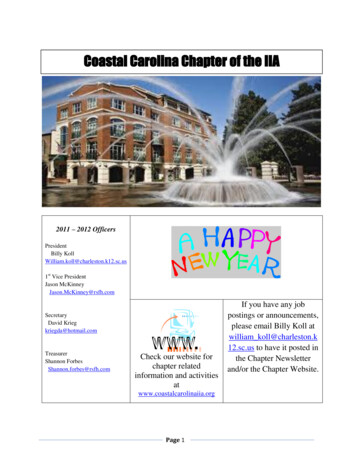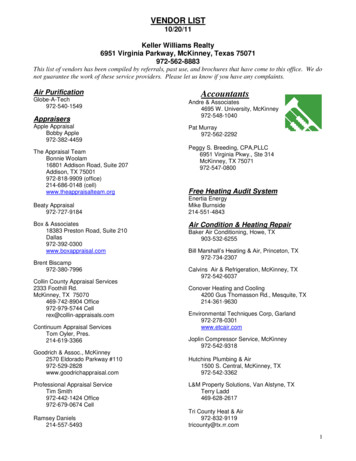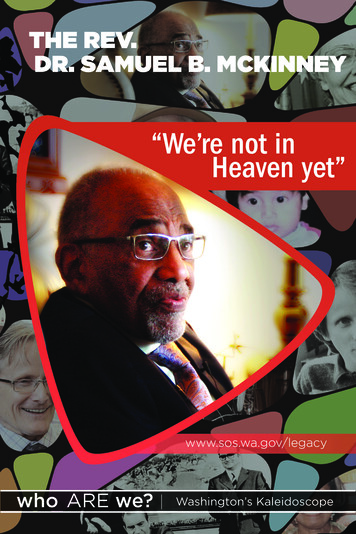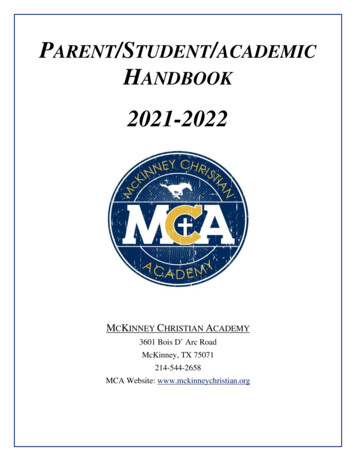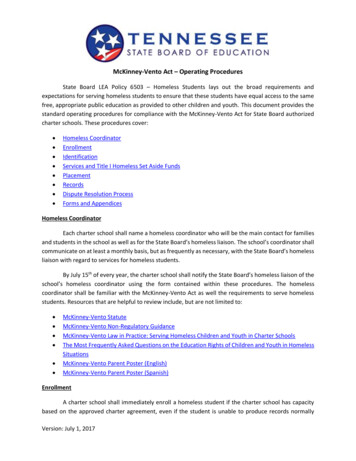
Transcription
McKinney-Vento Act – Operating ProceduresState Board LEA Policy 6503 – Homeless Students lays out the broad requirements andexpectations for serving homeless students to ensure that these students have equal access to the samefree, appropriate public education as provided to other children and youth. This document provides thestandard operating procedures for compliance with the McKinney-Vento Act for State Board authorizedcharter schools. These procedures cover: Homeless CoordinatorEnrollmentIdentificationServices and Title I Homeless Set Aside FundsPlacementRecordsDispute Resolution ProcessForms and AppendicesHomeless CoordinatorEach charter school shall name a homeless coordinator who will be the main contact for familiesand students in the school as well as for the State Board’s homeless liaison. The school’s coordinator shallcommunicate on at least a monthly basis, but as frequently as necessary, with the State Board’s homelessliaison with regard to services for homeless students.By July 15th of every year, the charter school shall notify the State Board’s homeless liaison of theschool’s homeless coordinator using the form contained within these procedures. The homelesscoordinator shall be familiar with the McKinney-Vento Act as well the requirements to serve homelessstudents. Resources that are helpful to review include, but are not limited to: McKinney-Vento StatuteMcKinney-Vento Non-Regulatory GuidanceMcKinney-Vento Law in Practice: Serving Homeless Children and Youth in Charter SchoolsThe Most Frequently Asked Questions on the Education Rights of Children and Youth in HomelessSituationsMcKinney-Vento Parent Poster (English)McKinney-Vento Parent Poster (Spanish)EnrollmentA charter school shall immediately enroll a homeless student if the charter school has capacitybased on the approved charter agreement, even if the student is unable to produce records normallyVersion: July 1, 2017
required for enrollment (i.e., academic records, immunization records, health records, proof of residency),or missed the charter school’s application or enrollment deadlines.Identification New Student Enrollment: Each school’s homeless coordinator is responsible for ensuring thathomeless students are quickly identified. Therefore, upon enrollment, all parents/guardians shallcomplete the student residency questionnaire in order to identify homeless students and ensurethese students have access to education and support services. If a parent/guardian indicates onthe questionnaire that the family lives in a residence that is not permanent, fixed, or adequate,the school’s homeless coordinator should immediately initiate the McKinney-Vento checklistincluded in these procedures.Mid-Year Change of Status: The school must conduct ongoing awareness and outreach strategiesduring the school year to identify students who may be homeless or become homeless during theschool year. These activities include placement of posters in the school setting, offering trainingto parents/guardians, and outreach to local shelters or community service organizations. If aschool is notified that a student has become homeless during the academic year, the homelesscoordinator should work with the parent/guardian to complete the required residencyquestionnaire and initiate the McKinney-Vento checklist included in these procedures.A completed copy of the checklist and accompanying documents shall be sent to the State Board’shomeless liaison within two (2) business days of completion of the checklist. Additionally, each school’shomeless coordinator shall ensure that informational posters for parents/guardians and youth are postedin well-trafficked areas of the school in a language that parents/guardians can understand. Questionsthroughout the process should be directed to the State Board’s homeless liaison.Services and Title I Homeless Set Aside FundsThe charter school’s homeless coordinator shall ensure that each homeless student is providedservices comparable to those offered to other students within the school, including transportation, specialeducation services, programs in career and technical education, programs for gifted and talentedstudents, and school nutrition. These services include, but are not limited to, obtaining or providing:1 Items of clothing, particularly if necessary to meet a school’s dress or uniform requirement;Clothing and shoes necessary to participate in physical education classes;Student fees that are necessary to participate in the general education program;Personal school supplies such as backpacks and notebooks;1National Center for Homeless Education, “Serving Students Experiencing Homelessness under Title I, Part A,”Winter 2014, https://nche.ed.gov/downloads/briefs/titlei.pdf; and National Association for the Education ofHomeless Children and Youth and National Law Center on Homelessness and Poverty, “ The Most FrequentlyAsked Questions on the Education Rights of Children and Youth in Homeless Situations,” September legis/2016-09-26 FAQ FINAL.pdf.2Version: July 1, 2017
Birth certificate necessary for the student to enroll in school;Immunizations;Food;Medical and dental services;Eyeglasses and hearing aids;Counseling services to address anxiety related to homelessness that is impeding learning;Outreach services to students living in shelters, motels, and other temporary residences;Extended learning time (before and after school, Saturday classes, summer school) to compensatefor lack of quiet time for homework in shelters or other overcrowded living conditions;Tutoring services, especially in shelters or other locations where homeless students live;Parental involvement activities specifically oriented to reaching out to parents/guardians ofhomeless students;Fees for AP and IB testing; and/orFees for SAT/ACT testing.Annually, as a part of the district plan and budgeting process, the district is required to set-asideTitle I funds on the district level to serve homeless students if all other school and community resourcesare exhausted. Each year, authorized charter schools must complete the Annual Needs Assessment forHomeless Students form included in these procedures. A charter school must demonstrate that it hasexhausted all school and community resources before requesting to use the reserved funds to servehomeless students. Incremental transportation costs for homeless students (costs above what the schoolwould have otherwise provided to transport the student) are not reimbursable through the district setasides and shall be paid for out of the school’s general purpose BEP funds or other philanthropic resources(if applicable).PlacementThe charter school’s homeless coordinator shall work with the school leader or designee on theplacement process. At all times, a strong presumption that keeping the student in the school of origin 2 isin the student’s best interest shall be maintained, unless doing so would be contrary to a request madeby the student’s parent/guardian or the student in the case of an unaccompanied youth. Whendetermining placement, student-centered factors, including but not limited to impact of mobility on2Per State Board LEA Policy 6503, school of origin shall mean the school that a child or youth attended when lastpermanently housed or the school in which the child or youth was last enrolled, including a preschool/pre-kprogram. Therefore, in the case of the State Board’s authorized charter school, the school of origin shall mean:(1) The authorized charter school, if it was the school that a child or youth attended when last permanentlyhoused; or (2) A child or youth’s local attendance zone school in which the student was last enrolled, including apreschool/pre-k program, if the student has submitted an application for enrollment into a charter school. Schoolof origin shall also include the designated receiving school at the next grade level when the student completes thefinal grade level served by the school of origin.3Version: July 1, 2017
achievement, education, health, and safety shall be considered. The charter school’s homelesscoordinator shall immediately notify the State Board’s homeless liaison regarding a placement decision.If the charter school determines that is not in the student’s best interest to attend the school oforigin or the school requested by the parent/guardian or unaccompanied youth, the school leader ordesignee shall provide a written explanation of the reasons for the determination, in a manner and formthat is understandable to the parent/guardian and unaccompanied youth. The written explanation shallinclude a statement regarding the right to appeal the placement decision to the State Board’s homelessliaison and the dispute resolution process provided in these procedures. A copy of the written statementshall be sent to the State Board’s homeless liaison within 48 business hours of the placement decision.RecordsThe charter school’s homeless coordinator shall ensure that each student who is identified ashomeless is coded accurately in the State Board’s student information system. The State Board will runreports on the students identified as homeless in EIS on a regular basis and cross reference with the datareported to the State Board homeless liaison by each charter school.The charter school homeless coordinator shall maintain a list of the homeless students whoenrolled in the charter school without immunization or proof of immunization and the length of timerequired for these students to be immunized or to obtain immunization records. An annual report withthis data is due to the State Board’s homeless liaison by May 15th.Dispute Resolution ProcessThe McKinney-Vento Act requires that each local education agency (LEA) has a dispute resolutionprocess in place. State Board LEA Policy 6503 – Homeless Students states that if a placement decision isappealed, the authorized charter school shall refer the parent/guardian or unaccompanied student to theState Board’s homeless liaison to begin the dispute resolution process. Upon notice of an appeal, theschool shall immediately enroll the student in the school in which enrollment was sought pending a finalresolution of the dispute including all available appeals. The dispute resolution process is as follows:Dispute Resolution Process Level 1: State Board’s Homeless LiaisonIf a parent/guardian or unaccompanied youth wishes to appeal a charter school’s decision relatedto eligibility, enrollment, or school selection, the case should be appealed to the State Board’s homelessliaison or the charter school where the dispute is taking place.1. The request for dispute resolution shall be filed by:a. Submitting a form that initiates the dispute resolution process to either the State Board’shomeless liaison or the charter school’s homeless coordinator, who sends the form to theState Board’s homeless liaison.i. If the form is submitted to the charter school’s homeless coordinator, the schoolshall immediately forward the request to the State Board’s homeless liaison.4Version: July 1, 2017
2.3.4.5.6.b. The request for dispute resolution must be submitted within five (5) business days ofreceiving the written notification of the determination;c. In the event that the State Board’s homeless liaison is unavailable, a State Board designeemay receive the request to initiate the dispute resolution process.The State Board’s homeless liaison shall log their receipt of the complaint, including the date andtime, with a written description of the situation and the reason for the dispute, and a copy of thecomplaint must be forwarded to the liaison’s immediate supervisor and the State Board’s Directorof Schools.The State Board’s homeless liaison shall review the record of the complaint and, if possible,interview the parent/guardian either in-person or via telephone.Within five (5) business days of their receipt of the complaint, the liaison must make a decisionon the complaint and inform the parent/guardian or unaccompanied youth in writing the result.It is the responsibility of the State Board to verify the parent’s/guardian’s or unaccompaniedyouth’s receipt of the written notification regarding the homeless liaison’s Level 1 decision.If the parent/guardian or unaccompanied youth disagrees with the decision made and wishes tomove the dispute resolution process forward to Level 2, the parent/guardian or unaccompaniedyouth shall notify the State Board’s homeless liaison of their intent to proceed to Level 2 withinfive (5) business days of receipt of notification of the Level 1 decision.If the parent/guardian or unaccompanied youth wishes to appeal the liaison’s Level 1 decision,the State Board’s homeless liaison shall provide the parent/guardian or unaccompanied youthwith an appeals package containing:a. A copy of the parent’s/guardian’s or unaccompanied youth’s complaint which was filedwith the district’s homeless liaison at Level 1;b. The decision rendered at Level 1 by the school district’s liaison; andc. Any additional information from the parent/guardian, unaccompanied youth, and/orhomeless liaison.Dispute Resolution Process Level 2: State Board’s Director of SchoolsIf after Level 1 of the Dispute Resolution Process the dispute remains unresolved, theparent/guardian or unaccompanied youth may appeal the State Board’s homeless liaison’s Level 1decision to the State Board’s Director of Schools through the following process.1. If a parent/guardian disagrees with the decision rendered by the State Board’s homeless liaisonat Level 1, the parent/guardian or unaccompanied youth may appeal the decision to the StateBoard’s Director of Schools or the Director of Schools’ designee using the appeals packageprovided at Level 1. The designee shall be someone other than the State Board’s homeless liaison.2. Within five (5) business days of receiving the notification of intent to proceed to Level 2 of thedispute resolution process, the Director of Schools, or the Director of Schools’ designee, willschedule a personal conference with the parent/guardian or unaccompanied youth. It ispreferable, but not required, for the conference to be in person if the schedules of the Directorof Schools and the parent/guardian or unaccompanied youth allow. If an in-person conference is5Version: July 1, 2017
not possible due to time and schedule constraints, a telephone conference may be used. Oncescheduled, the meeting between the Director of Schools or the Director of Schools’ designee andthe parent/guardian or unaccompanied youth is to take place as expeditiously as possible.3. The Director of Schools or the Director of Schools’ designee will provide a decision in writing tothe parent/guardian or unaccompanied youth with supporting evidence and reasons. It is theresponsibility of the State Board to verify the parent’s/guardian’s or unaccompanied youth’sreceipt of the written notification regarding the Director of Schools’ Level 2 decision.4. A copy of the appeals package, along with the written decision made at Level 2, is to be sharedwith the State Board’s homeless liaison.5. If the parent/guardian or unaccompanied youth disagrees with the decision made at Level 2 andwishes to move the dispute resolution process forward to Level 3, the parent/guardian or theunaccompanied youth shall notify the State Board’s homeless liaison of intent to proceed to Level3 within five (5) business days of receipt of the notification of Level 2 decision.Dispute Resolution Process Level 3: McKinney-Vento State CoordinatorIf after Level 2 of the Dispute Resolution Process the dispute remains unresolved, theparent/guardian or unaccompanied youth may appeal the State Board’s Director of Schools’ Level 2decision to the McKinney-Vento state coordinator through the following process.1. If the State Board’s homeless liaison is notified by the parent/guardian or unaccompanied youthof the intent to appeal the Level 2 decision, the State Board’s Director of Schools or designee shallforward all written documentation and related paperwork to the McKinney-Vento statecoordinator for review within five (5) business days of receiving the notification from theparent/guardian or unaccompanied youth.a. It is the responsibility of the State Board to ensure that the documentation that issubmitted is complete and ready for review at the time it is submitted to the statecoordinator.2. The McKinney-Vento state coordinator shall make a final decision within seven (7) business daysof receipt of the complaint.3. The final decision will be forwarded to the State Board’s homeless liaison for distribution to theparent/guardian and the State Board’s Director of Schools.Dispute Resolution Process Level 4: Executive Director of Consolidated Planning and MonitoringIf after Level 3 of the Dispute Resolution Process the dispute remains unresolved, theparent/guardian, unaccompanied youth, or the State Board may appeal the McKinney-Vento statecoordinator’s decision to the executive director of Consolidated Planning and Monitoring (CPM) at theTennessee Department of Education through the following process.1. The State Board, parent/guardian, or unaccompanied youth shall forward a written request tohave their case reviewed when there is a conflict with the decision rendered by the McKinney-6Version: July 1, 2017
2.3.4.5.Vento state coordinator within five (5) business days of receipt of the decision rendered at Level3 to the executive director of CPM.The executive director of CPM shall then forward a request to the McKinney-Vento statecoordinator to obtain all written documentation and related paperwork for review.Upon request of the executive director of CPM, the McKinney-Vento state coordinator shallforward all written documentation and related paperwork to the executive director of CPM forreview within three (3) business days of the request for documentation regarding the dispute.The executive director of CPM, along with the appropriate other department personnel, will makea final decision within seven (7) business days of receipt of all documentation and relatedpaperwork.The final decision will be forwarded to the State Board’s Director of Schools and homeless liaisonfor distribution to the parent/guardian or unaccompanied youth.The State Board shall maintain a record of all disputes related to the education of homelesschildren and youths. These records shall include disputes resolved at levels 1, 2, 3, and/or 4 and shall bemade available upon request by the Tennessee Department of Education.7Version: July 1, 2017
Forms and AppendicesThe following documents are required forms and sample templates for State Board’s authorizedschools to use when serving students experiencing homelessness. Unless specifically stated on thedocument, the charter school may adapt the form to its own context so long as the information requestedand provided on the sample template is contained within the adapted form.The forms and templates included are: School Level Homeless Coordinator Information – requiredAnnual Needs Assessment for Homeless Students – requiredMcKinney-Vento Checklist – requiredChecklist for Decision-Making – requiredUnaccompanied Youth Eligibility Flowchart - guidanceStudent Residency Questionnaire – templateCaregiver Form – templateNotification of Rights – templateWritten Enrollment Decision Notice – templateWritten Appeal of Enrollment Decision – requiredParent Transportation Contract – templateHomeless Set-Aside Reimbursement Form – required8Version: July 1, 2017
School Level Homeless Coordinator Information(Required)The McKinney-Vento Act (Title IX, Part A of the Every Student Succeeds Act) requires that everyschool district provide education and related services for students experiencing homelessness. In orderto ensure the State Board and its authorized charter schools remain in compliance with the law whileproviding an education of the highest quality to homeless students, a point of contact (“homelesscoordinator”) is needed in every building. This person will work with the State Board homeless liaison toensure students are identified and given appropriate opportunities to attend and succeed in school. Toassist with these tasks, the State Board homeless liaison will provide support and training for the schoollevel homeless coordinator.Please identify the most appropriate building level point of contact to serve as the charter school’shomeless coordinator and provide his or her information below. School Name:Contact Name:Direct Phone Extension:Email:If you need assistance determining the most appropriate person for this role in your building,please contact the State Board’s homeless liaison for assistance. This form is due to the State Board’shomeless liaison by July 15th of each year.The State Board’s homeless liaison is: Name: Tess StovallTitle: Director of Charter SchoolsDirect Phone Number: (615) 770-1190Email: tess.stovall@tn.govAdapted from materials from the National Center for Homeless Education Homeless Liaison Toolkit9Version: July 1, 2017
Annual Needs Assessment for Homeless StudentsAnnually, the State Board will budget in the Consolidated Funding Application for a homeless setaside of the district Title IA funds to pay for services for homeless students. A charter school mustdemonstrate that it has exhausted all school and community resources before requesting to use thereserved funds to serve homeless students. Incremental transportation costs for homeless students (costsabove what the school would have otherwise provided to transport the student) are not reimbursablethrough the district set-asides and shall be paid for out of the school’s general purpose BEP funds.In order to plan and budget appropriately, each school shall complete the annual needsassessment for homeless students and turn it into the State Board by February 1. Estimated Number of Homeless Students for Upcoming School Year:Rationale for estimate number (including an explanation if it is different from what is in EIS/SIS):The State Board and each authorizer charter school are required to provide services that supporthomeless students to succeed in school and to meet academic achievement standards. Title I funds cannotsupplant other state or local funds. Therefore, if a school used school or community resources to providea service, the school cannot request reimbursement of funds for the service.Needs Assessment for Services3Please mark with an “X” how the school plans to provide the below services, if necessary, tohomeless students. The school should utilize this as a part of the planning process for the upcoming schoolyear, and this will help the State Board in the district planning and budgeting process. The school may usemultiple resources for a service. If the school plans to use the district set-aside funds for the service, theschool must provide an explanation why school or community resources are not available. The submissionof this assessment does not constitute approval of the use of funds by the school.ServiceSchoolResourceCommunityResourceNeed SetAside FundsExplanationItems of clothing,particularly ifnecessary to meet a3Title IA funds can be used to provide the following services, but this should not be seen as an exhaustive list. Foradditional information, please see: National Center for Homeless Education, “Serving Students ExperiencingHomelessness under Title I, Part A,” Winter 2014, https://nche.ed.gov/downloads/briefs/titlei.pdf; and NationalAssociation for the Education of Homeless Children and Youth and National Law Center on Homelessness andPoverty, “ The Most Frequently Asked Questions on the Education Rights of Children and Youth in HomelessSituations,” September 2016; /2016-09-26 FAQ FINAL.pdf.10Version: July 1, 2017
ServiceSchoolResourceCommunityResourceNeed SetAside FundsExplanationschool’s dress oruniform requirementClothing and shoesnecessary toparticipate inphysical educationclassesStudent fees that arenecessary toparticipate in thegeneral educationprogramPersonal schoolsupplies such asbackpacks andnotebooksBirth certificatesnecessary to enroll inschoolImmunizationsFoodMedical and dentalservicesEyeglasses andhearing aidsCounseling servicesto address anxietyrelated tohomelessness that isimpeding learningOutreach services tostudents living inshelters, motels, andother temporaryresidencesExtended learningtime (before andafter school,Saturday classes,summer school) tocompensate for lackof quiet time forhomework inshelters or otherovercrowded livingconditions11Version: July 1, 2017
ServiceSchoolResourceCommunityResourceNeed SetAside FundsExplanationTutoring services,especially in sheltersor other locationswhere homelessstudents liveParentalinvolvementspecifically orientedto reaching out toparents/guardians ofhomeless studentsFees for AP and IBtestingFees for SAT/ACTtestingOther(please explain)Other(please explain)Other(please explain)Other(please explain)12Version: July 1, 2017
McKinney-Vento Checklist(required)Student Name:School:School Homeless Coordinator:Residency Questionnaire Completed (Should be given to every student upon enrollment or ifthe student experiences homelessness during the school year; send a copy to State Boardhomeless liaison with packet completed only when student qualifies for services.)Parent/Guardian InterviewDate of Interview Phone In-personIn/Out of Zone (Circle one)Current living situationArea of assistance neededImmediate provisionsDetermination of Status (send to SBE Homeless Liaison with packet)Notification of Rights and Services provided to parent/guardianDate Parent/Guardian Signature Y / N (Circle One)Transportation Request (Y / N) (Circle One)How is the school accommodating this request (manner and funding source)?School contact for transportation servicesNotification of Food ServiceWritten Notification of Enrollment Decision Provided to Parent(s)/Guardian(s) (include inpacket to SBE homeless liaison)Once verification is made, make copies of appropriate forms and send packet with originalpaperwork to SBE homeless liaison.Written Appeal of Enrollment (send to SBE homeless liaison only in the case of denial)Dispute Resolution (use only in appeal situation)Change of Status (copy for school; send original to SBE homeless liaison)Send copy of checklist along with packet to the State Board’s homeless liaison.13Version: July 1, 2017
Checklist for Decision-Making(required)School of Origin Considerations Continuity of InstructionStudent is best served due to circumstancesthat look to his or her past.Local Attendance Area School Considerations Continuity of InstructionStudent is best served due to circumstancesthat look to his or her future. Age and Grade Placement of the Student Age and Grade Placement of the StudentMaintaining friends and contacts with peers isMaintaining friends and contacts with peers incritical to the student’s meaningful schoolthe school of origin is not particularly critical toexperience and participation. The student hasthe student’s meaningful school experience andbeen in this environment for an extendedparticipation. The student has attended theperiod of time.school of origin for only a brief time. Academic Strength Academic StrengthThe student’s academic performance is weakThe student’s academic performance is strongand the student would fall further behind ifand at grade level; the student would likelyhe/she transferred to another school.recover academically from a school transfer. Social and Emotional State Social and Emotional StateThe student is suffering from the effects ofThe student seems to be coping adequatelymobility, has developed strong ties to thewith mobility, does not feel strong ties to thecurrent school, and does not want to leave.current school, and does not mind transferring. Distance of the Commute and Its Impact Distance of the Commute and Its ImpactThe advantages of remaining in the school ofA shorter commute may help the student’sorigin outweigh any potential disadvantagesconcentration, attitude, or readiness for school.presented by the length of the commute.The local attendance area school can meet allof the necessary educational and special needsof the student. Personal Safety of the Student Personal Safety of the StudentThe school of origin has advantages for theThe local attendance area schoolsafety of the student.advantages for the safety of the student.has Student’s Need for Special Instruction Student’s Need for Special InstructionThe student’s need for special instruction, suchThe student’s need for special instruction, suchas Section 504 or special education andas Section 504 or special education and relatedrelated services, can be better met at theservices, can be met at the local attendanceschool of origin.area school. Length of Anticipated Stay Length of Anticipated StayThe student’s current living situation is outsideThe student’s current living situation appearsof the school of origin’s attendance zone, butstable and unlikely to change suddenly; thethe living situation continues to be uncertain.student will benefit from developing14Version: July 1, 2017
The student will benefit from the continuityoffered by remaining in the school of origin.relationships with peers in school who live inthe local community.15Version: July 1, 2017
Unaccompanied Youth Eligibility Flowchart(guidance)The following is a flowchart intended to serve as a general guide for determining the status ofunaccompanied youth. Please note that all McKinney-Vento determinations should be made on a caseby-case basis, weighing the individual circumstances of each student. To be eligible for McKinney-Ventoservices as an unaccompanied homeless student, the student must meet the criteria of both homelessand unaccompanied.Guiding QuestionsIs the st
The McKinney-Vento Act requires that each local education agency (LEA) has a dispute resolution process in place. State Board LEA Policy 6503 - Homeless Students states that if a placement decision is appealed, the authorized charter school shall refer the parent/guardian or unaccompanied student to the






